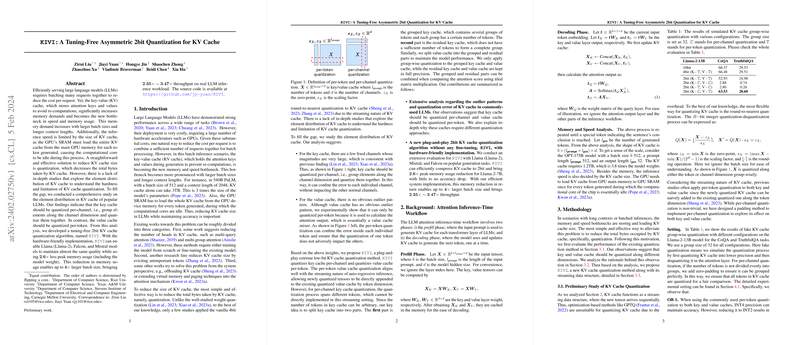KIVI: A Tuning-Free Asymmetric 2bit Quantization for KV Cache
Introduction
The research paper titled "KIVI: A Tuning-Free Asymmetric 2bit Quantization for KV Cache" addresses the core issue of efficient deployment of LLMs. The paper focuses on optimizing the key-value (KV) cache used during batch processing to significantly reduce memory and computational overhead while maintaining model accuracy. The innovative approach proposed in the paper revolves around the quantization of KV cache, allowing for reduced memory footprint and enhanced throughput without necessitating complex hyperparameter tuning.
Key Contributions
- Comprehensive Analysis of KV Cache Distribution:
- The authors conducted an extensive analysis of the element distribution within KV cache across popular LLMs. Their findings revealed distinct distribution patterns for key and value caches, leading to the conclusion that key cache should be quantized per-channel while value cache should be quantized per-token.
- Proposed Methodology - KIVI:
- Leveraging their analysis, the authors developed KIVI, a tuning-free 2bit KV cache quantization algorithm. KIVI adopts an asymmetric quantization scheme, quantizing key cache per-channel and value cache per-token. This design aligns well with the streaming nature of auto-regressive inference and minimizes quantization error.
- Hardware-Friendly Implementation:
- The algorithm implementation is optimized for GPU execution, incorporating fused operations for dequantization and matrix multiplication to maximize computational efficiency. This ensures that the reduction in memory usage translates directly to increased throughput.
- Experimental Validation:
- Extensive experiments were conducted on various LLMs, including Llama (Llama-2), Falcon, and Mistral models. The results demonstrated that KIVI can achieve up to 2.6x reduction in peak memory usage and up to 3.47x throughput improvement while maintaining almost the same accuracy.
Experimental Results and Implications
- Accuracy and Efficiency:
- The experiments showed that KIVI maintains high accuracy on normal and long-context generation tasks, with only a minimal drop in performance. For instance, the Llama-2-7B model experienced less than a 1% decrease in accuracy for key-generation tasks when using 2bit KIVI.
- Memory and Throughput:
- KIVI demonstrated significant memory savings, enabling up to 4x larger batch sizes. This directly translates to higher throughput, crucial for practical deployment scenarios where computational resources are a limiting factor.
- Detailed Ablation Studies:
- The authors provided detailed ablation studies focusing on key hyperparameters like group size and residual length. These studies affirmed the robustness of KIVI, showing that it performs optimally across a range of parameter settings without extensive tuning.
Theoretical and Practical Implications
The research has significant implications in both theoretical and practical domains:
- Theoretical Insights:
- The paper advances our understanding of the element distribution within KV caches of LLMs. It highlights the importance of applying different quantization strategies to different components of the KV cache, thereby minimizing quantization errors and preserving model performance.
- Practical Deployments:
- KIVI's tuning-free nature and hardware-friendly design make it suitable for real-world applications where computational efficiency and memory usage are critical. This could significantly lower the deployment costs of large-scale LLMs, making them more accessible for various applications.
Future Developments
The paper lays a strong foundation for future research in several areas:
- Integration with Other Techniques:
- KIVI can be integrated with other system-level and algorithmic optimizations, such as memory management strategies and weight quantization techniques, to further enhance efficiency.
- Broadening Applicability:
- Future work could explore the application of KIVI to other types of neural networks and further optimize the quantization process to reduce overhead during inference.
- Optimization of Implementation:
- Further efforts could be directed towards optimizing the implementation, potentially integrating quantization processes with previous layers to reduce latency and improve overall system performance.
Conclusion
The paper makes significant strides in the efficient deployment of LLMs by addressing the KV cache bottleneck through innovative quantization strategies. KIVI offers a practical, tuning-free solution that enhances memory efficiency and throughput without compromising on accuracy. This work paves the way for the broader adoption of large-scale neural networks in resource-constrained environments, bringing us closer to deploying advanced AI models in everyday applications.
